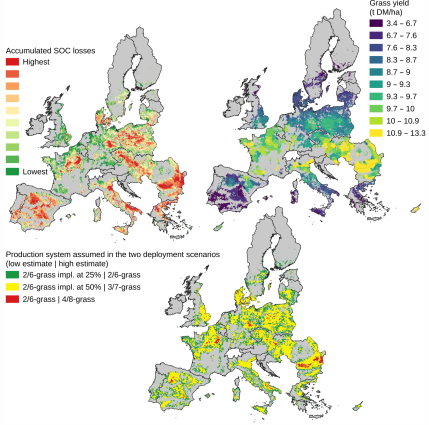Widespread deployment of grass in crop rotations – A multifunctional climate mitigation strategy
Strategic establishment of perennial plants in agricultural landscapes can provide environmental benefits while maintaining, or increasing, total biomass production. One such option, common in northern Europe, is to include grass in rotations with annual crops to provide biomass while remediating soil organic carbon (SOC) losses and other environmental impacts (e.g., reducing nitrogen emissions to water, as well as wind and water erosion). Results from research involving scientists at five European universities and Joint Research Centre (JRC), the European Commission’s science and knowledge service, show that widespread deployment of such systems can provide significant climate mitigation and several important co-benefits.
Members of IEA Bioenergy Task 43 (Biomass Supply) and Task 45 (Sustainability & Climate Change) were involved in this research.
The scientific paper was published in the Journal GCB Bioenergy in November 2022, and is available in open access here: Large-scale deployment of grass in crop rotations as a multifunctional climate mitigation strategy
Approach
Suitable areas for introducing grass cultivation in crop rotations were identified based on spatially explicit data on agricultural land-use and cumulative soil SOC losses in >81,000 sub-watersheds in EU27+UK (Europe). Several rotation systems and deployment scenarios were evaluated, considering the resulting changes in cropland use for annual crops and grass cultivation, production of biomass, protein and biogas, and effects on SOC, soil erosion by wind and water, nitrogen emissions to water, and flood mitigation.
Findings
Introduction of grass cultivation in rotations dominated by annual crops resulted in significant environmental benefits. When the grass is used to produce biogas and protein feed in biorefineries, the estimated annual GHG savings from soil carbon sequestration and displacement of natural gas with biogas correspond to 13-48% of current agriculture emissions in Europe. Yield gains for crops grown in rotation with grass and the use of grass as feedstock in lieu of annual crops reduces the displacement effect. Substitution of soybean feed can help reduce emissions and biodiversity loss from tropical forest conversion to soybean cultivation.

Accumulated soil organic carbon losses, simulated grass yields, and production systems implemented in the two deployment scenarios, based on estimated effectiveness to remediate soil carbon losses.

Effects of increased grass cultivation in crop rotations on the production of annual crops, compared to a reference case with annual crops in monoculture.
Article citation: Englund, O., Mola- Yudego, B., Börjesson, P., Cederberg, C., Dimitriou, I., Scarlat, N., & Berndes, G. (2022). Large-scale deployment of grass in crop rotations as a multifunctional climate mitigation strategy. GCB Bioenergy, 00, 1–19. https://doi.org/10.1111/gcbb.13015


